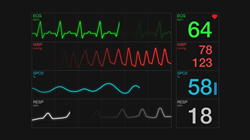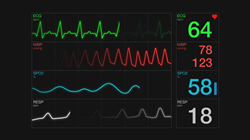
According to recent estimates, as many as 30 million Americans will use remote patient monitoring (RPM) tools by 2024.
The goal is to monitor people during everyday activities, because doctors want to see if it’s those that cause cardiac issues. But many people live with the misconception that they need to reduce their normal, everyday activities because they’re wearing a monitor.
WALTHAM, Mass. (PRWEB)
October 18, 2021
According to recent estimates, as many as 30 million Americans will use remote patient monitoring (RPM) tools by 2024.(1) The COVID-19 pandemic accelerated the use of remote monitoring and diagnostic devices, especially among cardiology practices. But many healthcare consumers still don’t trust these technologies. According to some studies, as many as 30% of elderly patients don’t want to share their private patient data with others in person or use RPMs.(2) This can prevent their effective use. These devices are seen as stop-gaps for when traditional, in-person appointments simply aren’t possible.
However, communication between the provider and patient is key for overcoming misconceptions, says Stuart Long, CEO of InfoBionic. For example, a cardiologist can dispel the myth that patients can’t exercise while wearing an RPM. It’s important that the patient continue on about their regular activities—cardiologists need this to happen in order to capture data about cardiac events during normal life. To help ensure this happens, and to collect the most accurate data possible, cardiologists need to watch out for any concerns people may have and address them immediately.
Remote patient monitoring and diagnostic devices are used for intermittent or continuous monitoring of patients with heart problems. They range from smartwatches to Holter monitors to Event monitors to near-real time remote diagnostic devices. In cardiology, remote patient monitors provide cardiac telemetry information including onset, offset, and other supplementary data used in diagnosis and management of cardiovascular conditions.(3)
When used correctly, these technologies allow for ongoing monitoring at home and can help prevent hospitalization and readmission to the hospital. However, patients commonly express concern about wearing or using their device during showering, exercising, or other activities. As a result, many mistakenly assume they need to be inactive for the technology to work correctly. “The goal is to monitor people during everyday activities, because doctors want to see if it’s those that cause cardiac issues. But many people live with the misconception that they need to reduce their normal, everyday activities because they’re wearing a monitor,” Long says,
In terms of functionality, remote cardiac telemetry devices don’t transmit information to doctors immediately. Only more advanced technologies provide information in near-real time. For many devices, lag prevents data from reaching providers and can impact a doctor’s ability to provide accurate and reliable results, sometimes for weeks to months. This lag also plays into patient mistrust of these devices. Immediate access to data collected from the patient can help cardiologists assuage patient fears that such technology can’t provide real-time benefits.
Only remote monitoring and diagnostic devices, such as InfoBionic’s platform, generate automated reports that can be accessed anytime, 24/7 through a secure HIPAA-compliant portal. The device can be used as a Holter, Event, and MCT depending on the patient’s needs and the suspected diagnosis. It is the only device of its kind to provide such a high level of functionality while also providing data to providers so they can make decisions about patient care sooner.
But patients can’t always immediately begin utilizing RPM technologies. Instead, most insurance companies require patients to try alternatives first. For example, a patient may be required to wear a two-day Holter monitor before another device will be considered for coverage. Even so, it’s likely the patient would have to use another monitor for a minimum of 30 days. Only after exhausting most or all other options would a patient be approved for a mobile cardiac telemetry (MCT) device.
“It’s very reassuring for patients to know that, if they’re wearing a monitor, it will continuously record data and immediately transmit it to a doctor. Then, the doctor can review that information to arrive at a diagnostic conclusion. More information captured on a timelier basis is key for helping patients live healthier,” says Long.
About InfoBionic:
InfoBionic is a digital health company transforming the efficiency and economics of ambulatory remote patient monitoring processes by optimizing clinical and real-world utility for the users that need it most – physicians and their patients. The Massachusetts-based team of seasoned entrepreneurs have had successful careers in healthcare, IT, medical devices and mobile technology, and bring specific expertise in remote monitoring and cardiology. They have seen first-hand the complexities of traditional cardiac arrhythmia detection and monitoring processes and designed the transformative MoMe® Kardia platform to remove the roadblocks hindering faster, more effective diagnosis and decision-making. Frost & Sullivan bestowed the 2019 North American Remote Cardiac Monitoring Technology Leadership Award upon InfoBionic.
1. Dolan, Shelagh. “The Technology, Devices, and Benefits of Remote Patient Monitoring in the Healthcare Industry.” Insider Intelligence, insiderintelligence.com/insights/remote-patient-monitoring-industry-explained/.
2. “Getting Seniors to Accept Remote Patient Monitoring.” RemetricHealth, 31 Aug. 2021, remetrichealth.com/getting-seniors-to-accept-remote-patient-monitoring/.
3. “Remote Patient Monitoring Represents Paradigm Shift after COVID-19.” DAIC, 1 Oct. 2021, dicardiology.com/content/remote-patient-monitoring-represents-paradigm-shift-after-covid-19.
4. “Continuous Cardiac Monitoring Solution: Cardiac Monitor for Full Disclosure MCT.” InfoBionic’s MoMe® Kardia System: Transforming the Efficiency of Arrhythmia Detection and Monitoring Management, 23 July 2021, infobionic.com/cardiac-monitoring-solution-how-it-works/.
Share article on social media or email:

